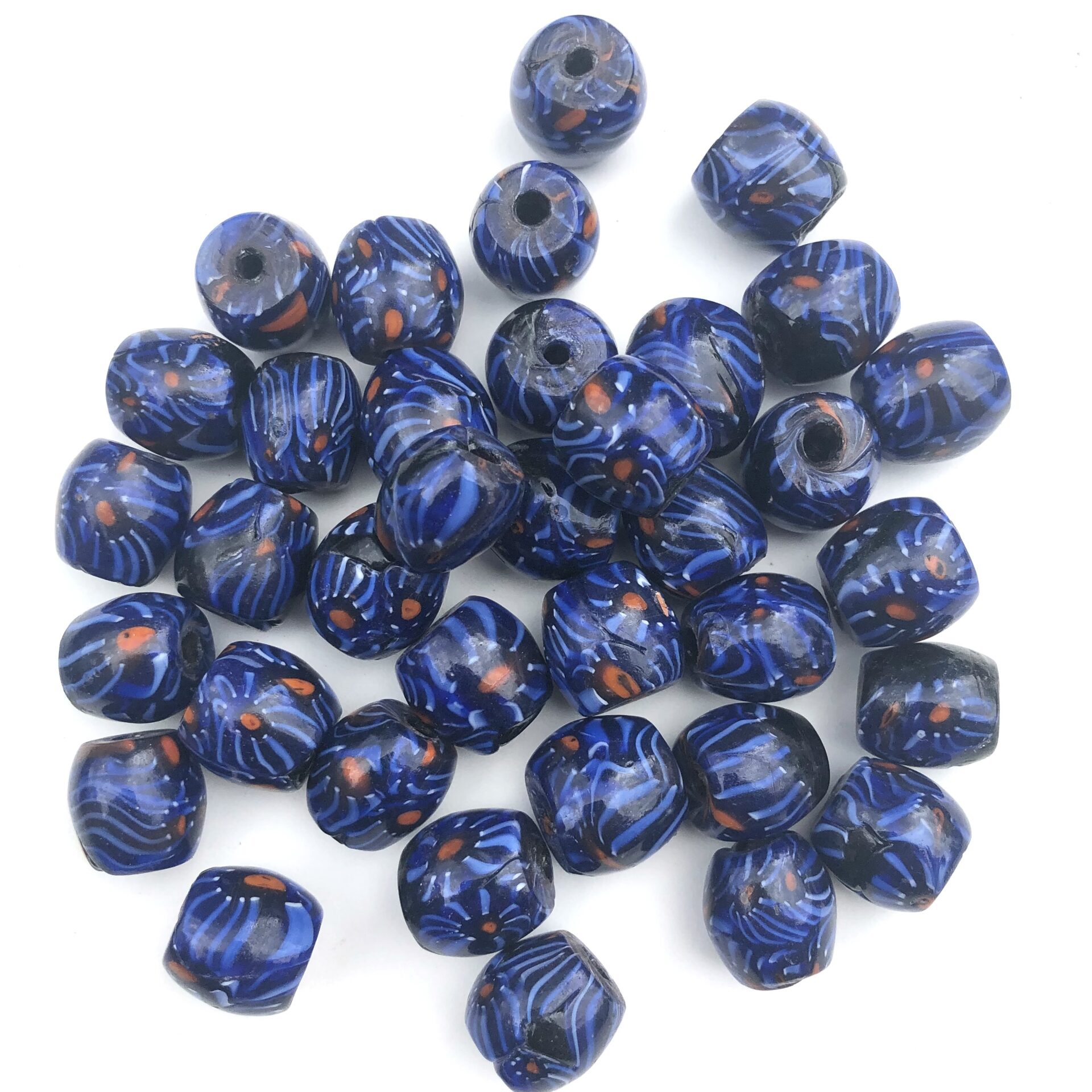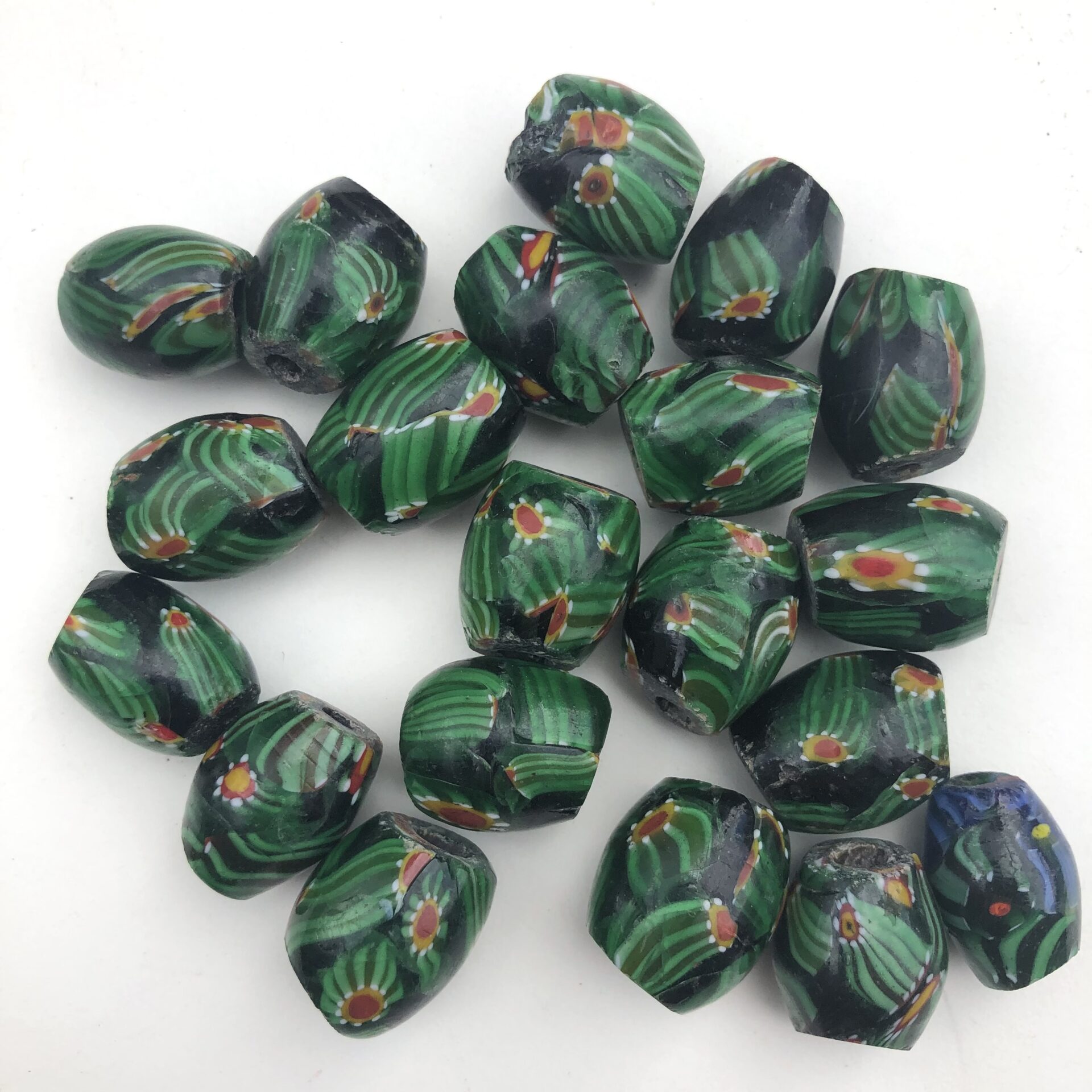-

 In Africa, these Bodom beads are held in the highest esteem and usually only worn for celebrations, funerals, and are often buried with the dead. There is much folklore about their magical powers as well. These bodoms have the evil eye. The belief in the ‘evil eye’ dates back thousands of years. It is one of the strongest symbolic symbols in the world. Wearing an evil eye as an amulet is believed to protect the wearer from evil forces. The evil eye has symbolism in practically every country in the world and every religion. Very powerful stuff! These impressive beads are still being made today in the same painstaking and labour intensive way as the ancestors. To see these beads being made please check out the blog, the Bodom. A strand of 26 brick red bodoms with a variety of coloured evil eye designs. Each Bodom is about 25 mm wide by 30 mm long with a 5 mm hole. These Bodoms were sourced directly from the Bead Artisan in Ghana, West Africa. As a strand they are gorgeous and impressive.
In Africa, these Bodom beads are held in the highest esteem and usually only worn for celebrations, funerals, and are often buried with the dead. There is much folklore about their magical powers as well. These bodoms have the evil eye. The belief in the ‘evil eye’ dates back thousands of years. It is one of the strongest symbolic symbols in the world. Wearing an evil eye as an amulet is believed to protect the wearer from evil forces. The evil eye has symbolism in practically every country in the world and every religion. Very powerful stuff! These impressive beads are still being made today in the same painstaking and labour intensive way as the ancestors. To see these beads being made please check out the blog, the Bodom. A strand of 26 brick red bodoms with a variety of coloured evil eye designs. Each Bodom is about 25 mm wide by 30 mm long with a 5 mm hole. These Bodoms were sourced directly from the Bead Artisan in Ghana, West Africa. As a strand they are gorgeous and impressive. -
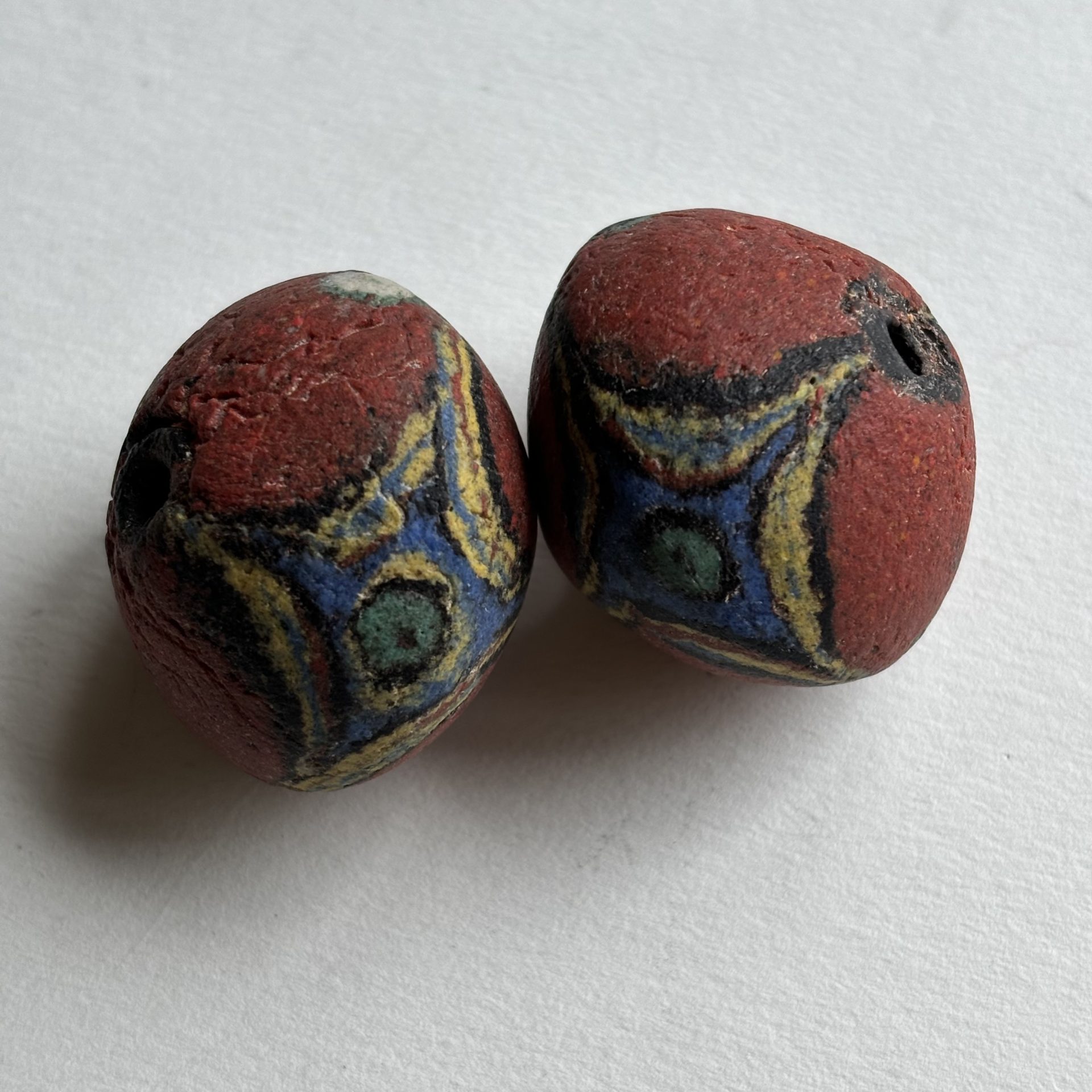
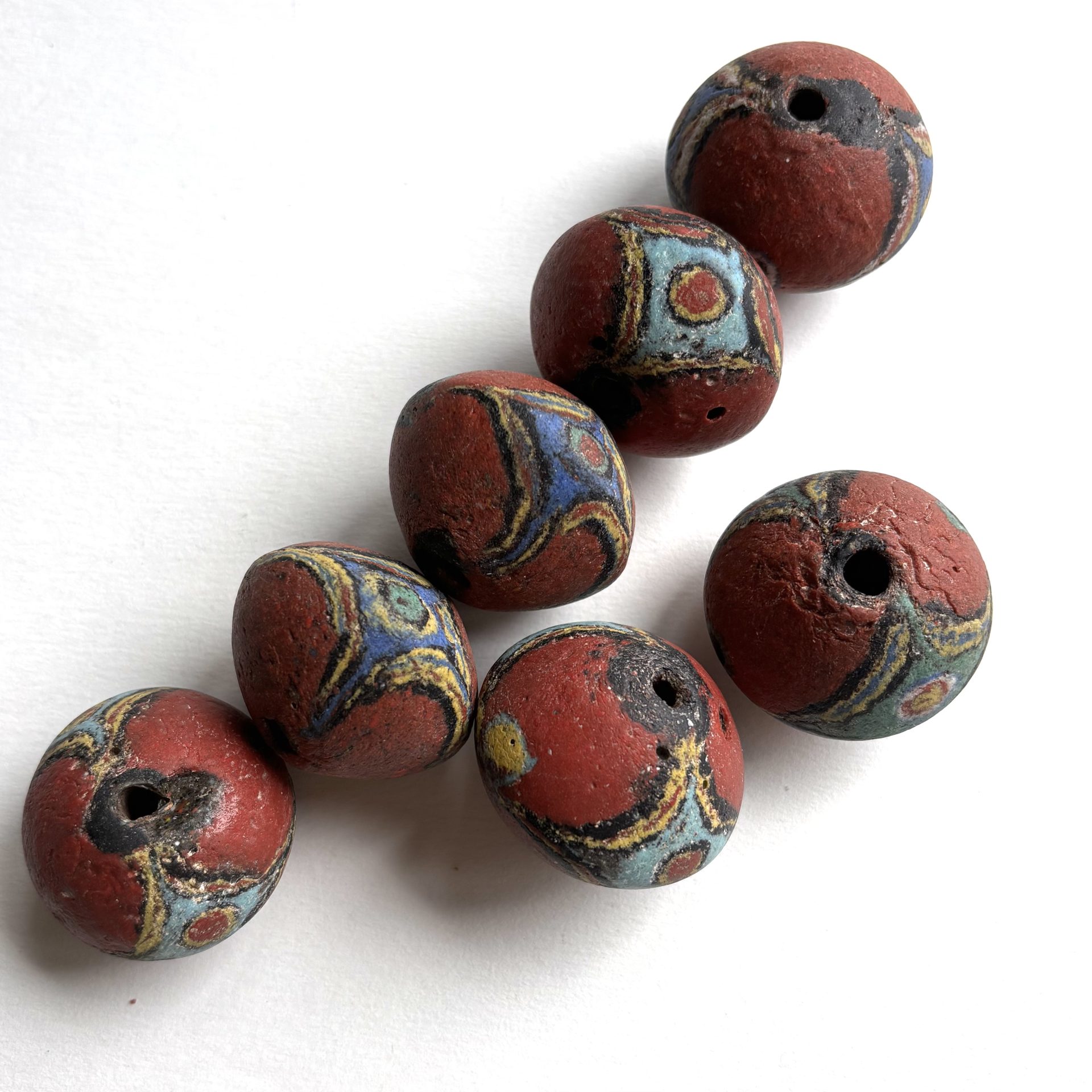 In Africa, these Bodom beads are held in the highest esteem and usually only worn for celebrations, funerals, and are often buried with the dead. There is much folklore about their magical powers as well. These bodoms have the 'evil eye'. The belief in the ‘evil eye’ dates back thousands of years. It is one of the strongest symbolic symbols in the world. Wearing an evil eye as an amulet is believed to protect the wearer from evil forces. The evil eye has symbolism in practically every country in the world and every religion. Very powerful stuff! These impressive beads are still being made today in the same painstaking and labour intensive way as the ancestors. To see these beads being made please check out the blog, the Bodom. There are 4 colour styles to choose from.
In Africa, these Bodom beads are held in the highest esteem and usually only worn for celebrations, funerals, and are often buried with the dead. There is much folklore about their magical powers as well. These bodoms have the 'evil eye'. The belief in the ‘evil eye’ dates back thousands of years. It is one of the strongest symbolic symbols in the world. Wearing an evil eye as an amulet is believed to protect the wearer from evil forces. The evil eye has symbolism in practically every country in the world and every religion. Very powerful stuff! These impressive beads are still being made today in the same painstaking and labour intensive way as the ancestors. To see these beads being made please check out the blog, the Bodom. There are 4 colour styles to choose from. -
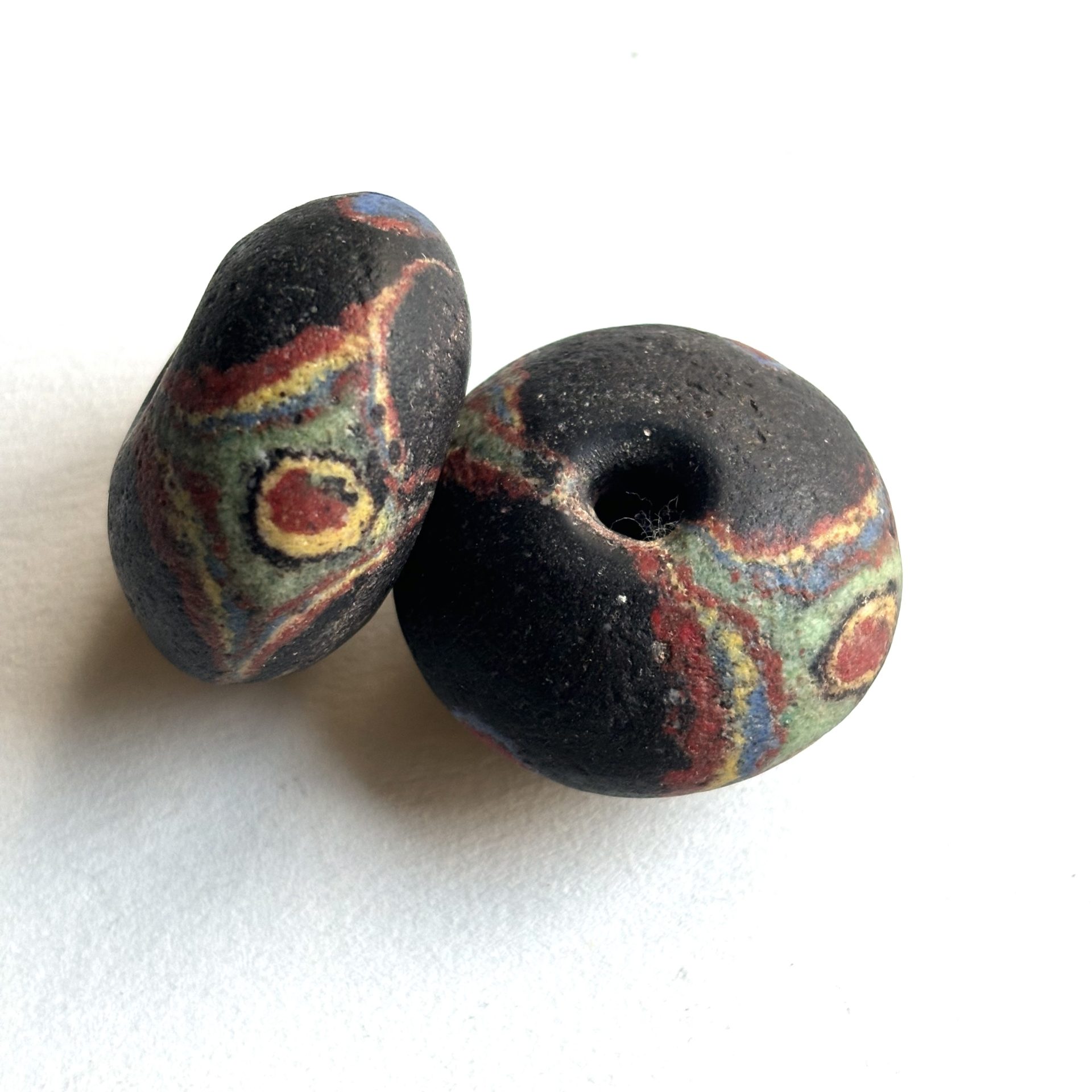
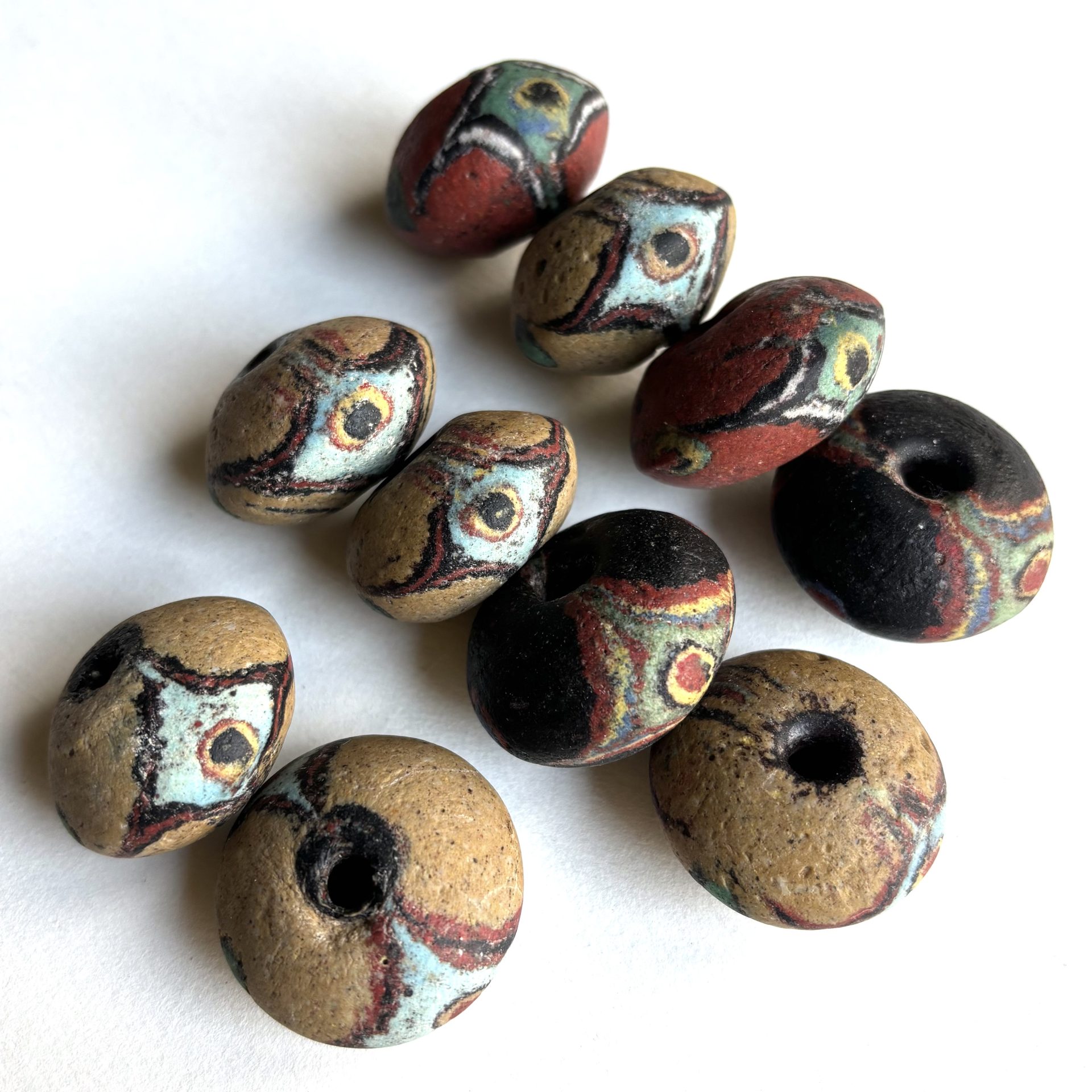 In Africa, these Bodom beads are held in the highest esteem and usually only worn for celebrations, funerals, and are often buried with the dead. There is much folklore about their magical powers as well. These bodoms have the 'evil eye'. The belief in the ‘evil eye’ dates back thousands of years. It is one of the strongest symbolic symbols in the world. Wearing an evil eye as an amulet is believed to protect the wearer from evil forces. The evil eye has symbolism in practically every country in the world and every religion. Very powerful stuff! These impressive beads are still being made today in the same painstaking and labour intensive way as the ancestors. To see these beads being made please check out the blog, the Bodom. These Bodom Bead are squashed bicone shaped and are about 2mmH x 3mmW . These medium beads are taupe, black and rust red with 'evil eye' designs. The hole is about 5 mm. The beads have a rough, earthy, organic feel to them. These beads are handmade so will have slight imperfections and vary in size, colour and shape. Please note these are contemporary beads made with heirloom powder glass that the Bead Maker said is rare.
In Africa, these Bodom beads are held in the highest esteem and usually only worn for celebrations, funerals, and are often buried with the dead. There is much folklore about their magical powers as well. These bodoms have the 'evil eye'. The belief in the ‘evil eye’ dates back thousands of years. It is one of the strongest symbolic symbols in the world. Wearing an evil eye as an amulet is believed to protect the wearer from evil forces. The evil eye has symbolism in practically every country in the world and every religion. Very powerful stuff! These impressive beads are still being made today in the same painstaking and labour intensive way as the ancestors. To see these beads being made please check out the blog, the Bodom. These Bodom Bead are squashed bicone shaped and are about 2mmH x 3mmW . These medium beads are taupe, black and rust red with 'evil eye' designs. The hole is about 5 mm. The beads have a rough, earthy, organic feel to them. These beads are handmade so will have slight imperfections and vary in size, colour and shape. Please note these are contemporary beads made with heirloom powder glass that the Bead Maker said is rare. -

 In Africa, these Bodom beads are held in the highest esteem and usually only worn for celebrations, funerals, and are often buried with the dead. There is much folklore about their magical powers as well. These bodoms have the 'evil eye'. The belief in the ‘evil eye’ dates back thousands of years. It is one of the strongest symbolic symbols in the world. Wearing an evil eye as an amulet is believed to protect the wearer from evil forces. The evil eye has symbolism in practically every country in the world and every religion. Very powerful stuff! These impressive beads are still being made today in the same painstaking and labour intensive way as the ancestors. To see these beads being made please check out the blog, the Bodom. This large Bodom Bead is triangular and is 31mmH x 25mmW . This medium bead is rust red with the 'evil eye' design. The hole is about 5 mm. The bead has a rough, earthy, organic feel to it.
In Africa, these Bodom beads are held in the highest esteem and usually only worn for celebrations, funerals, and are often buried with the dead. There is much folklore about their magical powers as well. These bodoms have the 'evil eye'. The belief in the ‘evil eye’ dates back thousands of years. It is one of the strongest symbolic symbols in the world. Wearing an evil eye as an amulet is believed to protect the wearer from evil forces. The evil eye has symbolism in practically every country in the world and every religion. Very powerful stuff! These impressive beads are still being made today in the same painstaking and labour intensive way as the ancestors. To see these beads being made please check out the blog, the Bodom. This large Bodom Bead is triangular and is 31mmH x 25mmW . This medium bead is rust red with the 'evil eye' design. The hole is about 5 mm. The bead has a rough, earthy, organic feel to it. -

 Colourful strand of large 25 fancy Indian Glass Beads that apparently traveled all the way from India to West African Bead Market.. then brought to Canada by Funky Frog – jet set beads! However the Beads Trader told me they were from Nigeria. While research this bead i could not find any related beads except the glass beads coming from India ... if anyone know these beads please contact us! The beads are about 13x29 mm. There is a smaller version of these beads which you can check out by clicking here. They are pictured together in the last photo.
Colourful strand of large 25 fancy Indian Glass Beads that apparently traveled all the way from India to West African Bead Market.. then brought to Canada by Funky Frog – jet set beads! However the Beads Trader told me they were from Nigeria. While research this bead i could not find any related beads except the glass beads coming from India ... if anyone know these beads please contact us! The beads are about 13x29 mm. There is a smaller version of these beads which you can check out by clicking here. They are pictured together in the last photo. -
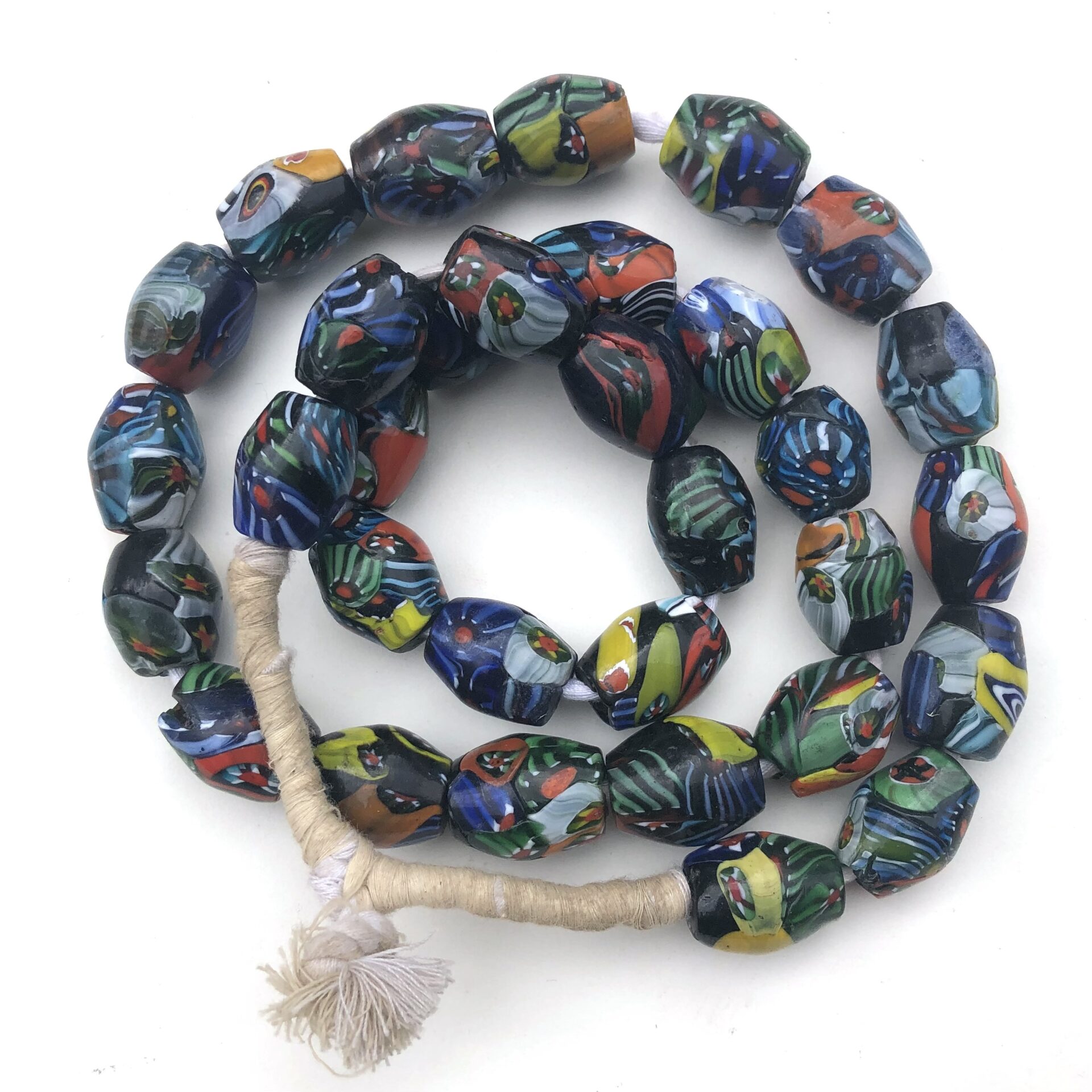
 Venetian Trade Beads from Venice have always been coveted , both in West Africa, where they were shipped to starting as early as the late 19th century, and in Europe and North America. India has been making beads for centuries and started making beads that look like the Venetian Trade Beads from about 1980. The Indian beads are generally larger than the original Venetian beads with larger holes . These Indian Venetian Beads found their way to Ghana’s Bead Markets where Funky Frog found them and was captivated by their colourful and varied shapes. This strand of 34 beautiful Venetian Glass beads are about 4x20mm. They are handmade so will vary in size , shape and colour.
Venetian Trade Beads from Venice have always been coveted , both in West Africa, where they were shipped to starting as early as the late 19th century, and in Europe and North America. India has been making beads for centuries and started making beads that look like the Venetian Trade Beads from about 1980. The Indian beads are generally larger than the original Venetian beads with larger holes . These Indian Venetian Beads found their way to Ghana’s Bead Markets where Funky Frog found them and was captivated by their colourful and varied shapes. This strand of 34 beautiful Venetian Glass beads are about 4x20mm. They are handmade so will vary in size , shape and colour. -
Out of stock

 Millefiori Trade Beads from Venice have always been coveted , both in West Africa, where they were shipped to starting as early as the late 19th century, and in Europe and North America. Many of you will know these beads as ‘love beads’ from the 60’s! Millefiori or ‘thousand flowers’ Beads are made by places slices of cane bead on a core of molten glass. Over the years these beads’ value have soared so it is no wonder other places started to make copies of these beads. India has been making beads for centuries and started making beads that look like the Venetian Trade Beads from about 1980. These beads are generally larger than the original Venetian beads with larger holes . These Indian Venetian Beads found their way to Ghana’s Bead Markets where Funky Frog found them and was captivated by their colourful and varied shapes. This strand of 20 colourful millifiori beads are about 11x18 mm. They are handmade so will vary in size, shape and colour.
Millefiori Trade Beads from Venice have always been coveted , both in West Africa, where they were shipped to starting as early as the late 19th century, and in Europe and North America. Many of you will know these beads as ‘love beads’ from the 60’s! Millefiori or ‘thousand flowers’ Beads are made by places slices of cane bead on a core of molten glass. Over the years these beads’ value have soared so it is no wonder other places started to make copies of these beads. India has been making beads for centuries and started making beads that look like the Venetian Trade Beads from about 1980. These beads are generally larger than the original Venetian beads with larger holes . These Indian Venetian Beads found their way to Ghana’s Bead Markets where Funky Frog found them and was captivated by their colourful and varied shapes. This strand of 20 colourful millifiori beads are about 11x18 mm. They are handmade so will vary in size, shape and colour. -

 A strand of Kakamba Prosser Beads about 23" long. The glass beads are about 5 mm in diameter. These are great spacer beads. An assortment of colours. You will receive a strand similar to the strands shown. There are variations between strands. Prosser beads are by extension any beads made by the 'Prosser' technique, invented by the Prosser brothers in 1840 in England for the purpose of making buttons. The process consists of molding a cold paste under great pressure and then firing it. Prosser Beads were distinct from other European trade beads in that they were produced in a great variety of colors, and were also translucent. They were received particularly well in the town of Kakamba in the Republic of the Congo – hence the name Kakamba Prosser Beads.
A strand of Kakamba Prosser Beads about 23" long. The glass beads are about 5 mm in diameter. These are great spacer beads. An assortment of colours. You will receive a strand similar to the strands shown. There are variations between strands. Prosser beads are by extension any beads made by the 'Prosser' technique, invented by the Prosser brothers in 1840 in England for the purpose of making buttons. The process consists of molding a cold paste under great pressure and then firing it. Prosser Beads were distinct from other European trade beads in that they were produced in a great variety of colors, and were also translucent. They were received particularly well in the town of Kakamba in the Republic of the Congo – hence the name Kakamba Prosser Beads. -

 A strand of Kakamba Prosser Beads about 23" long. The glass beads are about 6-9 mm in diameter. These are great spacer beads. An assortment of colours and sizes. You will receive the strand shown. Prosser beads are by extension any beads made by the 'Prosser' technique, invented by the Prosser brothers in 1840 in England for the purpose of making buttons. The process consists of molding a cold paste under great pressure and then firing it. Prosser Beads were distinct from other European trade beads in that they were produced in a great variety of colors, and were also translucent. They were received particularly well in the town of Kakamba in the Republic of the Congo – hence the name Kakamba Prosser Beads.
A strand of Kakamba Prosser Beads about 23" long. The glass beads are about 6-9 mm in diameter. These are great spacer beads. An assortment of colours and sizes. You will receive the strand shown. Prosser beads are by extension any beads made by the 'Prosser' technique, invented by the Prosser brothers in 1840 in England for the purpose of making buttons. The process consists of molding a cold paste under great pressure and then firing it. Prosser Beads were distinct from other European trade beads in that they were produced in a great variety of colors, and were also translucent. They were received particularly well in the town of Kakamba in the Republic of the Congo – hence the name Kakamba Prosser Beads. -

 A strand of Recycled Glass Waist beads strung on string 16" long. These are the smallest recycled glass beads and great spacer beads. These beads are a salmon red. There is an image which shows the different reds. And also an image that shows the two salmon reds. The salmon red is the lighter of the two. The waist beads are hand made and therefore there will be variations in size and colour. Funky Frog loves to use these beads in tassels!
A strand of Recycled Glass Waist beads strung on string 16" long. These are the smallest recycled glass beads and great spacer beads. These beads are a salmon red. There is an image which shows the different reds. And also an image that shows the two salmon reds. The salmon red is the lighter of the two. The waist beads are hand made and therefore there will be variations in size and colour. Funky Frog loves to use these beads in tassels! -

 A strand of about 27 tube shaped Recycled Glass Beads on string 24" long. There is a range of colours, textures, colours and shapes! You will receive a strand similar to the one in the photo with some variations. Ghana is famous for these recycled beads made from recycled glass bottles. These recycled beads were bought directly from the small factory in Accra, Ghana where the artisans hand make the beads in the labor intensive method of their ancestors from crushing glass to baking the final product in wood ovens. Please note the strand you will receive will be similar to the strand in the photo. There will be variations as the strand is hand strung and handmade.
A strand of about 27 tube shaped Recycled Glass Beads on string 24" long. There is a range of colours, textures, colours and shapes! You will receive a strand similar to the one in the photo with some variations. Ghana is famous for these recycled beads made from recycled glass bottles. These recycled beads were bought directly from the small factory in Accra, Ghana where the artisans hand make the beads in the labor intensive method of their ancestors from crushing glass to baking the final product in wood ovens. Please note the strand you will receive will be similar to the strand in the photo. There will be variations as the strand is hand strung and handmade. -

 A strand of opaque rose Rondelle Recycled Glass beads on string 22" long. These recycled beads were bought directly from the small factory in Accra, Ghana where the artisans hand make the beads in the labor intensive method of their ancestors from crushing glass to baking the final product in wood ovens.
A strand of opaque rose Rondelle Recycled Glass beads on string 22" long. These recycled beads were bought directly from the small factory in Accra, Ghana where the artisans hand make the beads in the labor intensive method of their ancestors from crushing glass to baking the final product in wood ovens.




